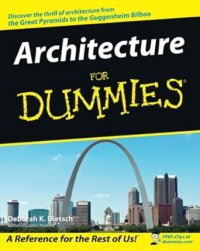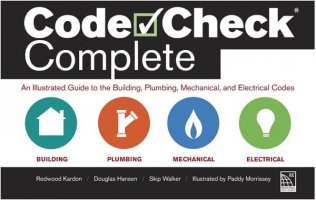Architecture for Dummies?
-
Welcome to The Building Code Forum
Your premier resource for building code knowledge.
This forum remains free to the public thanks to the generous support of our Sawhorse Members and Corporate Sponsors. Their contributions help keep this community thriving and accessible.
Want enhanced access to expert discussions and exclusive features? Learn more about the benefits here.
Ready to upgrade? Log in and upgrade now.
You are using an out of date browser. It may not display this or other websites correctly.
You should upgrade or use an alternative browser.
You should upgrade or use an alternative browser.
Somebody ought'a write a book
- Thread starter Yankee Chronicler
- Start date
mark handler
SAWHORSE
mark handler
SAWHORSE
Inspector Gadget
SAWHORSE
How about "Eleven ways to botch your building permit application?"
Yankee Chronicler
SAWHORSE
IMO It is lazy and irresponsible to not know what the codes are for the place you are building. It is an easy search to find out, or a quick phone call, 5 min. up front is all it would take. If I were the client I would not be happy with the design team.
It would be easy to say this is expected from of an out of state DP with our state stamp, but I see it from local DP's all the time as well. Part of it is the result of the myriad of different editions of the codes adopted by each AHJ. Still, it just seems like just a few minutes up front would be worth it, and should be expected.
We don't have different codes around the state. This state adopts the code on a state-wide basis, and local jurisdictions are NOT allowed to amend it. Period.
And we still get plans citing the wrong codes. We adopted an amended version of the 2021 I-codes in late 2022, so about a year and a half ago. I reviewed a set of plans today that referenced the 2015 IECC.
It wasn't too many weeks ago that I reviewed a set of plans that was chock full of references to BOCA!
Yikes
SAWHORSE
wwhitney
REGISTERED
Up.codes's list is not complete, they just stuck with the large jurisdictions. For a complete list of California jurisdictions that have filed amendments to the state building code, see:A quick review of UpCodes shows that only a few jurisdictions do this:
Local Amendments to Building Standards - Ordinances
Cheers, Wayne
Yikes
SAWHORSE
YC, are you looking for the minimum on plans for the purpose of plan check, or also the minimum on plans for best practice of avoiding field problems?I often hear building official colleagues complaining about the quality (or lack thereof) in the plans they receive for permits, and the frequently repeated lament is "Somebody ought'a write a book."
I'm an architect, and I'm also a writer. Over the years I have had articles published in several trade and professional magazines, I've written a number of (self-published) books, and I've even had a feature article in Fine Homebuilding magazine. So I've decided that if a book to tell architects what we need to see in construction drawings needs to be written and nobody else has stepped up to the plate, I may as well do it.
With that in mind, please let me know -- either with posts in this thread or by PM -- what you think architects need to be told to put in their drawings.
Thanks.
As an example:
The fire department plan checkers require us to have a note on the plans stating to the effect that fire extinguishers shall be located within 75' travel distance of all portions of the building.
This note is sufficient to get us through plan check. We are not required to show the locations of the FE's on the plans.
There was a time when I thought best practice to also provide the specific locations on the plans, so the framer knows were to block out for the semi-recessed cabinets. However, we have since found that we have less change orders when we simply require the contractor to coordinate with the fire department field inspector for final location / placement.
Shouldn’t those go hand in hand?looking for the minimum on plans for the purpose of plan check, or also the minimum on plans for best practice of avoiding field problems?
Yikes
SAWHORSE
Not always. It depends on the project procurement method.Shouldn’t those go hand in hand?
The code only requires the AHJ to inspect for code compliance, but not to ensure a smooth-running construction project.
Some owners are willing to pay for highly detailed plans to avoid problems in the field.
Others only want to pay design professionals for the bare minimum, either because (best case scenario) they have a talented construction team that doesn't need more detailed information on the plans, or (worst case scenario) because they are using labor that is so cheap that they are willing to risk tearing out and rebuilding it a second time rather than building it right the first time.
The latter occurs here in So Cal, where some owners and contractors rely on day-laborers to do their work.
Sifu
SAWHORSE
- Joined
- Sep 3, 2011
- Messages
- 3,568
I can't and won't speak the OP's intent, but I can speak for my own opinion. On average, a significant percentage of my comments are on the code analysis. Since it appears to be such a difficult concept for so many, it seems they could at least take the low hanging fruit off the table. In the example provided for fire extinguishers, it would be adequate, and preferred to have the comment rather than the specific location. It would not however, be acceptable for the code analysis to have a comment to comply with the applicable code as adopted. So my thought is to tackle the low hanging fruit, things EVERY plan submittal should have as a baseline. The details would be subject to the individual plan check and inspection needs.
I received one today with the wrong codes and the wrong construction type, has notes for a completely different AHJ, it was a single page for the architectural, no sections, interior details, RCP, door tags or schedules, finishes, framing plans or details, exterior or interior elevations or details, accessible details of any type, to name a few important elements. It is a first time tenant in a brand new core/shell, decent size A2. Maybe some think a 1-pager with none of these things is fine, but IMO it does not get anywhere near to being of sufficient clarity to determine code compliance. We even have a submittal document that lists many of these very things in case the DP doesn't understand this. This is the 2nd submittal, because the first was little better than a napkin sketch and I rejected it outright and explained exactly what should be submitted. I got this one page back.
Would this DP read YC's book? Probably not, and if they did would they pay attention? Probably not. However, to hear these basic issues from a DP does validate the position of us under-educated laymen.
There is another interesting thing about this particular submittal. When I rejected it the owner called me. He was incredulous that I needed sealed plans...never had to do that before! HE IS AN ENGINEER, and said I'll seal my own sketches. I said I expect the engineer to have proficiency in the subject matter, and that my comments would reflect this. So he apparently got someone to prepare this one page. And my comments will reflect this.
I'll stop providing examples of these issues, because I could provide a new one every day.
I received one today with the wrong codes and the wrong construction type, has notes for a completely different AHJ, it was a single page for the architectural, no sections, interior details, RCP, door tags or schedules, finishes, framing plans or details, exterior or interior elevations or details, accessible details of any type, to name a few important elements. It is a first time tenant in a brand new core/shell, decent size A2. Maybe some think a 1-pager with none of these things is fine, but IMO it does not get anywhere near to being of sufficient clarity to determine code compliance. We even have a submittal document that lists many of these very things in case the DP doesn't understand this. This is the 2nd submittal, because the first was little better than a napkin sketch and I rejected it outright and explained exactly what should be submitted. I got this one page back.
Would this DP read YC's book? Probably not, and if they did would they pay attention? Probably not. However, to hear these basic issues from a DP does validate the position of us under-educated laymen.
There is another interesting thing about this particular submittal. When I rejected it the owner called me. He was incredulous that I needed sealed plans...never had to do that before! HE IS AN ENGINEER, and said I'll seal my own sketches. I said I expect the engineer to have proficiency in the subject matter, and that my comments would reflect this. So he apparently got someone to prepare this one page. And my comments will reflect this.
I'll stop providing examples of these issues, because I could provide a new one every day.
Yankee Chronicler
SAWHORSE
YC, are you looking for the minimum on plans for the purpose of plan check, or also the minimum on plans for best practice of avoiding field problems?
Plan check. The aim of the book is to try to explain to idiot architects what the code REQUIRES them to include in the construction documents in order to get a permit.
Yankee Chronicler
SAWHORSE
I received one today with the wrong codes and the wrong construction type, has notes for a completely different AHJ, it was a single page for the architectural, no sections, interior details, RCP, door tags or schedules, finishes, framing plans or details, exterior or interior elevations or details, accessible details of any type, to name a few important elements. It is a first time tenant in a brand new core/shell, decent size A2. Maybe some think a 1-pager with none of these things is fine, but IMO it does not get anywhere near to being of sufficient clarity to determine code compliance. We even have a submittal document that lists many of these very things in case the DP doesn't understand this. This is the 2nd submittal, because the first was little better than a napkin sketch and I rejected it outright and explained exactly what should be submitted. I got this one page back.
Classic example of why I feel compelled to write this book. Will they read it? I agree -- most probably won't. I certainly don't expect to retire from the proceeds (I'll be lucky to live long enough to finish it). If it makes life easier/better for ten percent, or even one percent, of building officials and owners I will feel it has served a purpose. (I honestly don't care about the architects -- it's the owners who get screwed when their design professionals don't know which end it up.)
mark handler
SAWHORSE
In CA, charter cities can have their own codes....Here in California, once the state adopts a code, the local municipalities must either adopt that code or propose amendments within a certain time period. A quick review of UpCodes shows that only a few jurisdictions do this:
View attachment 12500
Mr. Inspector
SAWHORSE
I would like to know if any plan reviewers reject the plans right away when they have the wrong codes on it, or do you review everything anyway?
mtlogcabin
SAWHORSE
Reject no. Put on hold until the info on the code review sheet is corrected? Yes
Sifu
SAWHORSE
- Joined
- Sep 3, 2011
- Messages
- 3,568
There may have been a time or two, but typically I conduct the review based on the adopted codes, which usually doesn't reveal a lot of deficiencies because the wrong code edition was referenced or used in the design. I then just include the comment to provide reference and design to the adopted code along with my other comments. If the codes were not even close and/or I start to see multiple issues because of the different codes then I would reject it. I will not "approve" a plan with incorrect code references.I would like to know if any plan reviewers reject the plans right away when they have the wrong codes on it, or do you review everything anyway?




